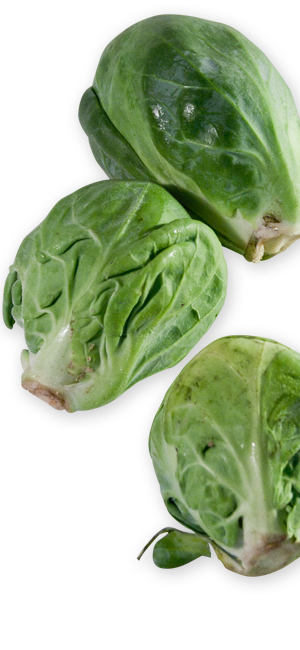One of the more intriguing looking plants in a garden setting, Brussels Sprouts form on a four foot stalk, setting what appear to be mini-cabbage heads along the length in a spiral configuration at the base of large green leaves that break down quickly enabling the sprouts to form. Each sprout swells to about 2 inches in diameter before harvesting. The top of the plant—which is never harvested—looks like an undernourished, straggling Savoy Cabbage. The Savoy is the headed cabbage most closely related to the Brussel sprout.
Planted from seed in March, under a cold frame in the north, in a nursery bed in the south, then transplanted to a sunny, open section of the garden.
The final plants are spaced at 18 inch intervals, sing the foliage does not spread greatly. In Belgium, the vegetable’s place of origin, taste preferred young sprouts, and anything markedly over a half an inch in diameter was disregarded. American tastes ran to fatter sprouts. Twelve days before harvest, the plant’s top was cut off. Harvesters cut the stem close to the bottom sprout and laid them in a shaded area until it was time to use them. Those plants reserved for seed would not be topped.
Although mentioned in M’Mahon’s pioneering 1806 Garden Calendar, it was quite uncommon in American in the early 19th century. Sometimes called the “thousand-headed cabbage,” it only became a featured specimen in experimental kitchen gardens in the 1850s, but not a common culinary plant. As late as 1894 market gardener Peter Henderson observed, “[t]his vegetable has never come into general use in this country, probably owing to its being too tender to stand the winters of the Northern States.”[1] If he had lived south of the Maxon-Dixon Line, he would have found the vegetable more in evidence, particularly as a kitchen garden, rather than a market garden, crop. Georgian William N. White counseled that frost-touched sprouts taste sweeter than regular crop—a controversial claim. He, like most southerners, thought them an ideal accompaniment to beef.
Commercial seed for Brussels sprouts proved unreliable with variety characteristics—primarily having to do with stalk size—unstable until rather late in the 19th century.
1. Peter Henderson, Gardening for Profit (New York: Orange Judd, 1894), p. 145.
Dwarf Brussels Sprouts History
A low-growing sort, usually from eighteen inches to two feet in height. It differs from the following variety principally in size, though it is somewhat earlier. The dwarf stems are said to produce heads which are more tender and succulent when cooked than those obtained from taller plants.
Tall Or Giant Brussels Sprouts History
Stem nearly four feet in height; plant healthy and vigorous, producing the small heads peculiar to its class in great abundance. It is somewhat hardier than the foregoing variety ; and, on account of its greater length of stalk, much more productive.
To Boil Brussels Sprouts (Gardening for the South 1867) History
Soak them in clear water one hour, and wash free from dust and insects. Boil them twenty minutes or until tender in plenty of water. Drain them well, season with pepper, salt, &c, to taste, a sauce of cream or floured butter, in which stew them gently, stirring them constantly ; or they may be cooked simply as cabbages and oaten with meats. William N. White, Gardening for the South (New York, 1867), p. 172.
Brussels Sprouts Saute (Miss Parloa’s Kitchen Companion 1887) History
Use one quart of sprouts, three table-spoonfuls of butter, one teaspoonful of sugar, one table-spoonful of salt, one teaspoonful of flour, and one-quarter of a teaspoonful of pepper. After ridding the sprouts of the loose hanging leaves, soak them in cold water for half an hour; then wash them, and put them on the stove in a stew-pan containing two quarts of boiling water. Boil for half an hour, adding a teaspoonful of salt at the end of the first ten minutes. At the end of the half-hour drain off all the water, and add the sugar, butter, pepper, flour, and one teaspoonful of salt. Shake the pan over the fire until the sprouts become colored slightly, — say for about four minutes; then turn the vegetables into a warm dish, and serve at once. Maria Parloa, Miss Parloa’s Kitchen Companion (Boston: Clover Publishing, 1887), p. 494.
Puree of Brussels Sprouts (Harder’s Practical American Cookery 1885) History
When the sprouts are boiled, drain them. Then put them into a saucepan with a piece of butter. Season them with salt, pepper and a little nutmeg. Toss them over the fire, adding some Cream sauce. Should the sprouts not be of a bright green color add some green of spinach. Rub the whole through a fine sieve. Return them to the saucepan and add a piece of butter and a few drops of meat glaze. Jules Arthur Harder, Physiology of Taste; or, Harder’s Practical American Cookery (San Francisco, 1885), p. 57.
Brussels-Sprouts Salad (Fifty Salads 1885) History
Pick over carefully a quart of sprouts, wash well, and boil rapidly for twenty minutes (if boiled slowly they lose their color). Drain, and plunge them into cold water. Drain again, and put them into a salad-bowl. Mince one-fourth of a pound of boiled ham, arrange it neatly and evenly around the sprouts, and around this arrange a border of potato salad. Add a plain dressing, a teaspoonful of herbs, and serve. Thomas Jefferson Murrey, Fifty Salads (New York: White, Stokes & Allen, 1885), p. 13.

